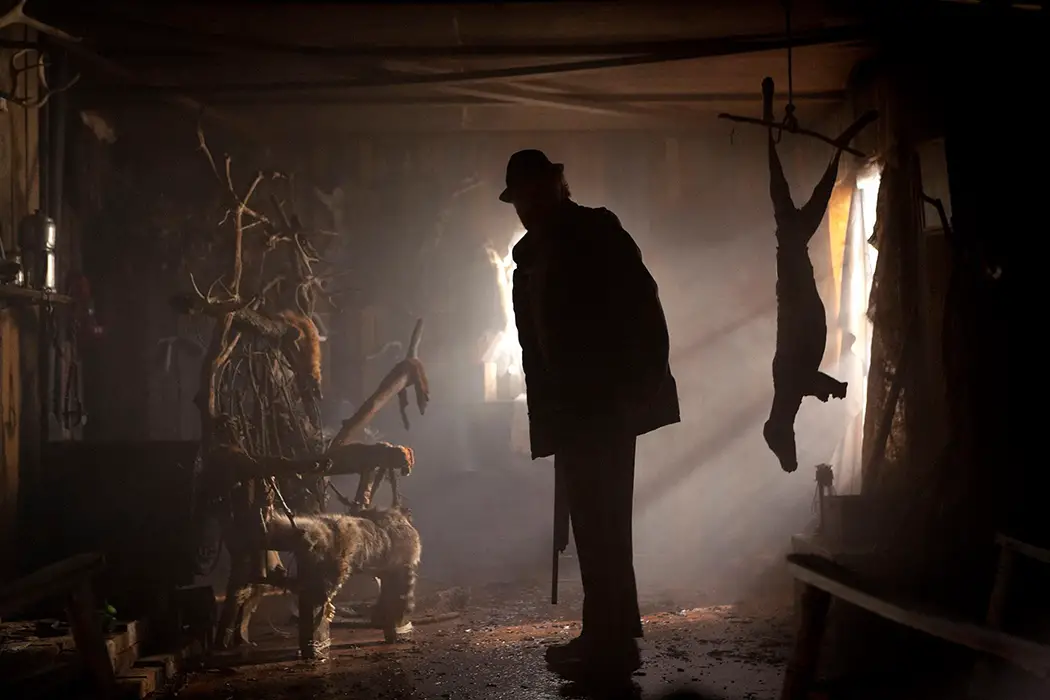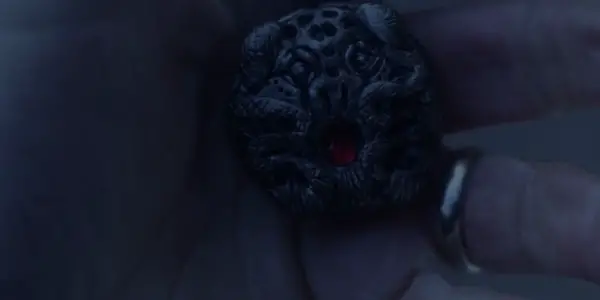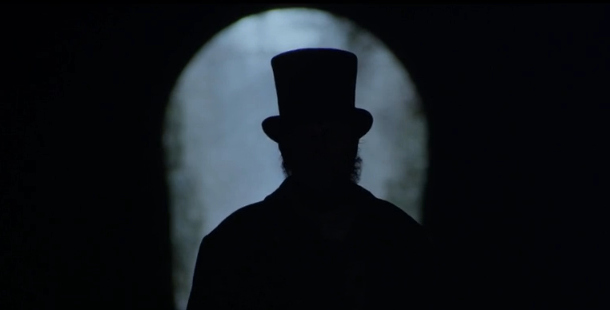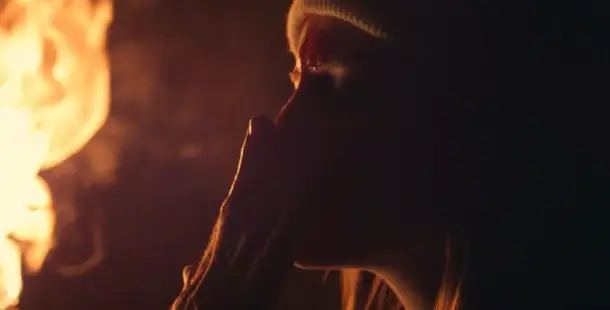DIG TWO GRAVES: A Visually Stunning Southern Gothic Nightmare

Chris is a B.A.H. graduate with a concentration in pre-19th…
With the cover-up of a gruesome set of murders in 1947, Dig Two Graves begins from a conflicted perspective. Jumping several decades to 1977, the story picks up a couple generations later to explore how sin always comes full circle. Director Hunter Adams fleshes out the story with the help of fittingly somber cinematography and the powerful performances of Ted Levine and Samantha Isler.
The story follows Jake Mather (Isler), who goes into the woods with her brother Sean one day only to return alone, her head split open after falling into a rock. Afterwards, Sean is declared dead, never to be seen again. This sets Jake on a revelatory journey towards truth, at any cost. When she receives an offer too good to be true, she’s sucked into a world somewhere between magic and revenge.
What starts as something akin to a fairy tale eventually becomes a fascinating Southern Gothic with grotesque characters, a lead whose gender defies stereotypical conventions, and a heavy dose of magic realism.
Southern Gothic
What gives the story its Southern Gothic elements, aside from a rural setting and tragic trajectory, are the characters. First of all, there’s Jake. Her lead role doesn’t conform with tired gender stereotyping. An atypical female character, her gender is nearly non-existent in traditional terms: she stands up physically for a boy getting his head flushed in the toilet; she also refuses the would-be romantic advances of the same boy; later on she gladly helps skin a bloody kill with her grandpa, without a flinch. Isler‘s portrayal of Jake is seamless.

Then there’s grandpa himself, Sheriff Waterhouse (Levine). His quality lies in the literary grotesque. His highly conflicted character allows us to empathise with his plight while simultaneously remaining revolted by his actions. In part, this drives many of the story’s thrills, as his involvement in the opening murder scene makes us question his credibility throughout the rest of the film.
Though the characters offer much of the Southern Gothic atmosphere, Adams brings a sense of magic realism into the mix with a number of impressive visuals and an overall moody atmosphere. This blurs the lines of whether the story is supernatural in nature, or if it is utterly, devastatingly human.
Magic Realism
Jake comes across a man named Wyeth (Troy Ruptash) who tells her curiously: “Your brother’s not dead, he’s just hard to find.” This intoxicating sentence reels her in, and suddenly she finds herself in the midst of a spooky voodoo pact. Jake believes that if she can complete a task for Wyeth, her brother will return. Through Wyeth’s suggestions, the quarry in their little town transforms from a useless backwoods location into one shrouded in the supernatural. This is when the cinematography really takes hold, moving from a mere dark motif into one full of eerie imagery.

Adams uses the voodoo to put the audience in Jake’s fragile headspace, conjuring up surreal images expected of a full-on horror film. We are meant to question what is real alongside her. One of the most striking images is when Wyeth runs into Jake’s pregnant mother; she drops some eggs on the ground and within the cracked yolks are pools of blood. Shortly after, she has a miscarriage. These moments reel us into that place again, where reality is not guaranteed, nor is it explicitly disputed. The disturbing and vivid imagery comes courtesy of Eric Maddison, whose lens captures the visuals necessary to imprint magic realism on this otherwise human story.
However, herein lies the ruse. Adams pulls us along in a riptide of emotion and interesting visuals, as Jake thirsts for any answer available to solve the mystery of her brother’s disappearance, and Wyeth promises her an explanation in the magic. Except, until the last scene the audience is never sure if the supernatural exists in this story, or rather if Jake has embarked, unknowing, on a horrible task.
Fairy Tale or Revenge Only?
The film’s ultimate power is in the finale. We wait so long to discover if Jake lives in a world of supernatural events or one wholly based in the cruelness of human beings. Ambiguity helps build the Southern Gothic mood. The story is told through imagery, rather than all dialogue and exposition; a testament to the screenplay by Adams and co-writer Jeremy Phillips. In turn, the answers aren’t given over to the audience before the last scene.

Adams doesn’t trick the viewer into believing revenge isn’t part of the plot. The story gives us a prescient feeling about the various flashbacks we see from the past of Sheriff Waterhouse. Despite ambiguity, there’s always a notion of the past triggering a brutal series of events in the present of the characters involved. It simply isn’t until the end that we understand the scope of the revenge at play, and who is pulling the strings.
There are definitely glimmers of positivity to the story’s conclusion, though the darkness rarely wavers. Toeing the line of magic realism and the prospect of a story hinging solely on revenge is a tightrope act, but it is one that Adams accomplishes with fine visual storytelling, aided by the strong performances from both Isler and Levine.
Conclusion
There’s never a lack of the essence which drives Dig Two Graves throughout its lean 85 minutes. Adams and Phillips could’ve easily filled their screenplay with lengthy monologues. Rather than that they’ve opted for a more mysterious story, driven by elements of the Southern Gothic genre and rich, dark visuals. The grotesque caricature of Sheriff Waterhouse, Isler’s Jake with her non-conformist female role, the voodoo imagery; these familiar pieces form a compelling puzzle.
A writer well-known for grotesque characters particularly, William Faulkner is famously quoted as saying: “The past is never dead. It’s not even past.” Any piece of Southern Gothic, regardless of medium, will deal heavily with the concept of old sins coming back to bear on the current lives of those who committed them.
Any story deemed as Southern Gothic will also likely end on a bittersweet note. Part of the past’s presence in the future becomes an acceptance of that past, for better or worse. Dig Two Graves embodies this acceptance by giving us a grim final scene, yet also allows room for hope to grow and for the past to fade into obscurity once and for all.
Does the Southern Gothic require a downbeat ending, or can its grim atmosphere stand up with an end that offers a ray of hope?
Dig Two Graves is coming to theaters and On Demand on March 24th.
Does content like this matter to you?
Become a Member and support film journalism. Unlock access to all of Film Inquiry`s great articles. Join a community of like-minded readers who are passionate about cinema - get access to our private members Network, give back to independent filmmakers, and more.
Chris is a B.A.H. graduate with a concentration in pre-19th century literature from Memorial University of Newfoundland. His short stories have been published in The Cuffer Anthology Volumes VI & VII, as well as upcoming stories in new anthologies from Centum Press (One Hundred Voices & One Hundred Voices Pt. II) and Science Fiction Reader. A short screenplay of his titled "New Woman" is currently being produced, to be shot in 2017; it is a female-led dramatic horror, a period piece set in 1888.












